Lewin Benjamin (ed.) Genes IX
Подождите немного. Документ загружается.

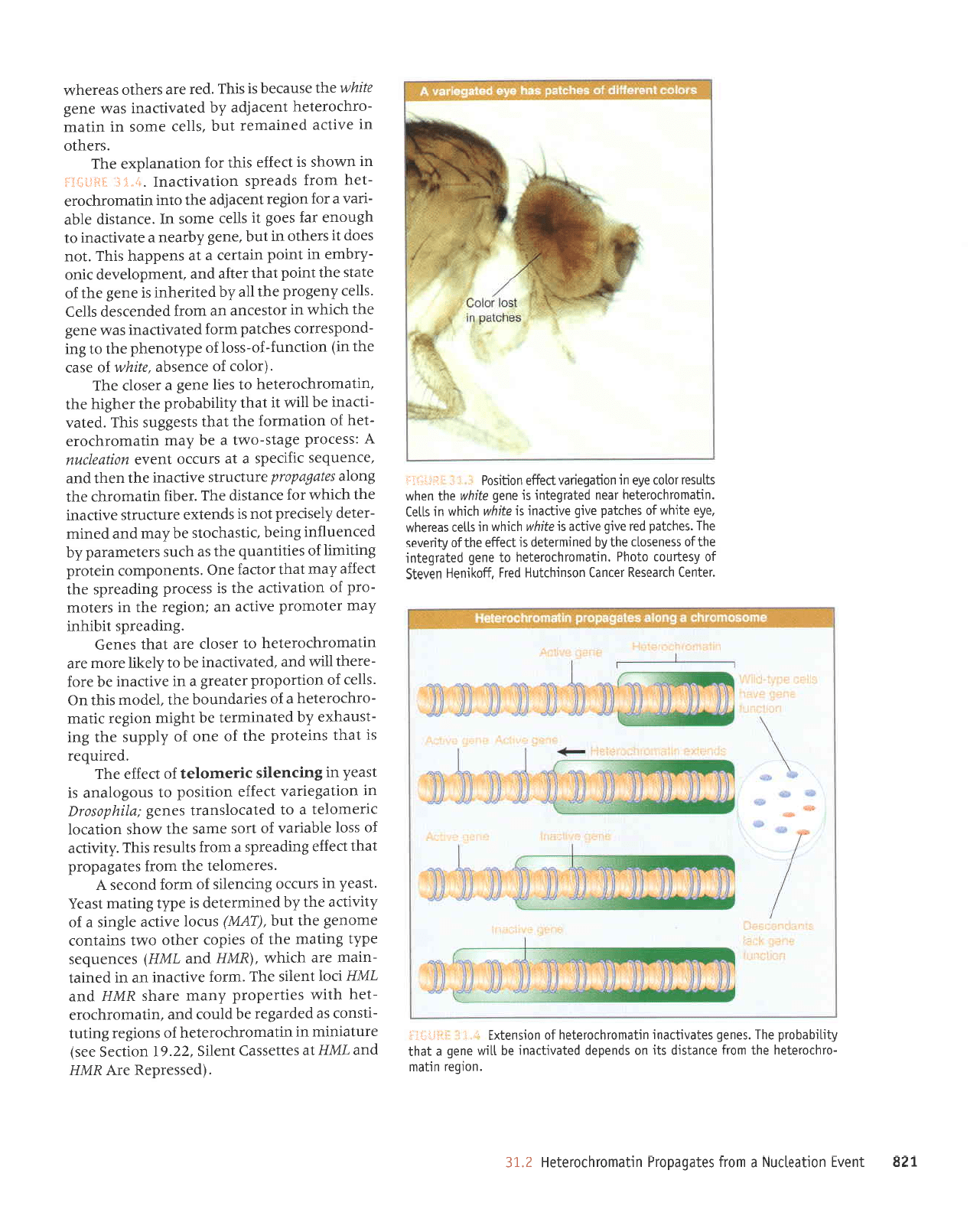
\28
lua^l
uoqeallnN e uo4 salebedold urleurolqloraleH
z'IE
'uotbel
utleul
-o.lqlololaq
aql urolJ aluPlsrp slr
uo spuadap
pale^rllPur
aq
llrM
aua6
e
]eql
filqrqeqord aql
'seua6
sele^rlrpur urleuo.lqlo.laloq
Jo
uorsualxl
,:
L
r :ijij:iil:
'l01u0l
qlleosou
laruPl uosurqllnH
pall
'#o)tueH
ua^els
jo
^salnol oloqd
'utleuolqrololoq
ol
aua6
pelP.lbalur
aql
Jo
sseuasoll
aql
^q
pourulalap
sr
paJJo
aql
jo
flua^as
aqt
'saLllled
pal
a^t6 o^tllP st allq^4
qltqM ut sllal
sealaqM
'er\a
eltqrut
1o
saqrled
antb anLpeut
st: allLlll
qltqM ut sllal
'urlpuolqlorelaq
reeu
paletbalut st auab allqlu
aql
uaqM
sllnso.l.lolol a^a
ut uoqebaue^pa#e
uoqtsod,
:
r:
.irjli::.i..
'(passardag
er17
AWH
pueTwHP se]l3ssP)
TDIS'ZZ'6I
uoIDeS
ees)
arnlprurru
ur urlPruoJqf,oJeleq
Jo
suoISeJ
3u11n1
-psuo)
se
papreSar Jq
plnoJ pue
'ulleluoJqJoJe
-teq
qlr^{
saluJdoJd
z(uBru
Jreqs
ur,LH
pue
TWH lJollualls
JqI
'IrrJoJ
JAI1)PuI
uE uI
pJulel
-ureur
arp
qJIqM
'(AWU
pue
TWH\
saJuJnbes
adz(l Surleru
Jq1
Jo
satdot
rJqlo o,lt.l
suleluoJ
aruoua8
Jq1
tnq
'(mfu
snJol
elp)e
a18uts e
Yo
,(tlrrr1re
aqt
r(q
pauruuJtap sl ad,{.l
Suueru
lsea
'1sBa,{
ur sJnlJo
Sunuags
Jo
rrlroJ
puoJas
Y
'saJJlrrolal
aqt
uoJJ sale8edord
teql
peIJJ
Surpeards
P uorJ
sllnsJr
stql
',hnqre
Jo
ssol alqerJP^
Jo
Uos
JrIIPS
aq1 ,\ol{s
uopeJol
JrJaruolel
P 01
pJleJolsuerl
saua8
:altqdosotq
ur uorleSarren
DeJJe
uorlrsod
o1 snoSoleue
sr
tsead
ur Supuags
JlJaurolel
io
IJJJJa
aqJ
'partnbar
sr
leql
sutatord
aqt
Jo
auo
Jo
[1ddns aql
8ur
-lsneqxe
,(q
paleullurat aq
lq31u
uot8ar
Ileru
-oJqloJelJq
e
Jo
salJPpunoq
eql
'leporu
slql
uo
'slleJ
Jo
uonrodord
ratear8
€
uI aAIDPUI
Jq aJoJ
-JJeql
IIrM
puP
'pele^IpPul
Jq ol
.,{.1a>1q arour
are
urleruoJqf,oJJleq
01 rasolJ
aJe
leq]
sJuJ)
'Surpeards
tlqlqul
,{eru
ralourord
arrtlre
uB
luor8ar Jql
uI sJalou
-ord
yo
uollelple
aql
sI sseJoJd
Surpeards
aql
page
^deru
1eql
rotJeJ
auo
'sluJuodruor
ulalord
Surlnuq
yo
saptluenb
Jql sP
qJns sralaruered
[q
pJruJnlJul
Suraq
'rrlseq.ro1s
aq
r{eur
pue
pJulru
-ralap
,(lasoard
lou
sI
spuelxe
arnlJnJls
JAI1JPUI
Jql
qlrqM JoJ eJuPlslp
eqJ
'JeqIJ
ulleruoJqJ
Jq1
3uo1e
salaCodotd
arntrnrls
JAIpeuI
aql
uaql
pue
'aruanbas
rqtrads
e
le
sJn)Jo
TueLJ
u}loapnu
y
:ssarord a8els-oazu
e
aq
[eur ulleuorqf,orJ
-taq
Jo
uollpluroJ
eql
1Pq1
slsa8Ens
sIqJ
'pele^
-rlrPul
eq
IIIM
11 ]eq1,{lUrqeqord
aqr
raqSq
aqr
'ulleruoJqJoJelaq
01 saq
aua8
e JasolJ
aqJ
'
(ro1ot
Jo
JJuesqe'
a1!14/vr
lo
JSeJ
eqt
ul) uorDunJ-Jo-ssol
Jo
ad,lrouaqd
Jql
ol3ul
-puodsa;ror
saqtled
ruroJ
pJl€Ap)euI se,u. aua8
Jql
qJII{'\ uI JolsJJuP
ue uroJJ
pepuaJsap sllef,
's11ar
^,{.ua8ord
aqt
1e
.{q
patrraqur sr aua8
aqt;o
etets
eqt
tqod
leqt
raqe
pue
'luaurdolalap
JIuo
-fuqrua
ur
lurod
uleueJ
e
tB
suaddeq
sIqJ
'lou
saop
1l
sJaqlo
u1
lnq'aua3,{.qreau
e a1elll)eul
ol
q8noua re;
sao8
1l
slleJ
elrros
uI
'aJuelslp
JIqe
-rJeA
p
JoJ
uo6er
luarefpe
eql
otul
upPtuoJqJoJJ
-tJq
uoJJ
speards
uollelllreul
'ie'i{
ilHl}ti-l
ur u,ltor,ls
sl
I)JIIJ
slql
JoJ uotteueldxa
aq1
.sJeqlo
ur aAIlJe
peulerual
lnq
'slleJ
Jruos
uI ullelu
-oJqJoJataq
luarefpe
z(q
palerrrpeur sem
aua8
a4r4L
erll
JsnPJeq
sI
sIqJ
'peJ
Jre
sJaqlo
seJrJqM
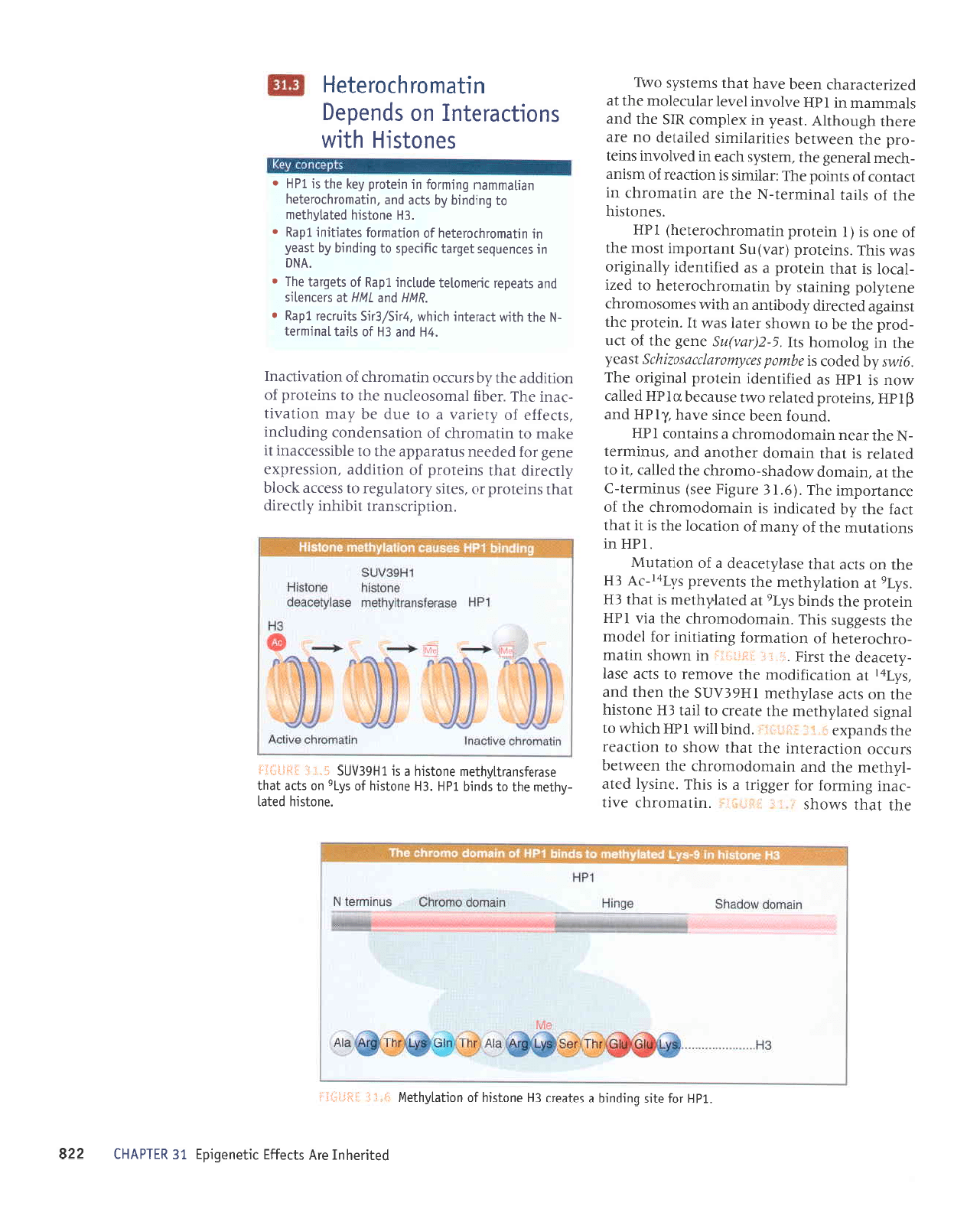
'IdH
loJ
olrs 6urpurq
p
saleell
EH
auolsrq
Jo
uoqel^qlal^l
-r.i,ii:
llitliliS:i
paluaqul
arv streJJl
lqauaEldl
t€
ulldvHl
zz8
eql
leql
SMOqS
.
i.:
-r:;:r
:ji
'uIlPLuoJq)
JAII
-Jpur
SururtoJ
JoJ
Ja38ul
e sr
srqJ
.Jurs^l
pelp
-l^qleu
Jqt
pue
uretuopotuoJqJ
Jqt uJJMtrq
srnJJo
uorlJeJelur
Jql
leql
Moqs
01
uorlJeJJ
aqlspuPdxJ
:
.
i
ii;::::i:i'pulqIIIM
IdHqJrqMo1
IpuSrs
pJlel^qlJu
rql
JteeJJ
o1
IIpl
€H
auolsrq
Jql uo
stJe
asel^qlJru
IH6€AnS
rql
ueql
pue
'S^frr
le
uoIlPJIJIpolu
eql aAoruJJ
01 slJe
asel
-.{lareap
Jql
lsJrd
':i"i
,:
ji:ri;:.]].:
ur uMoqs
urlpru
-OJqJOIJIJq
JO
UOI]EIuJOJ
SUI]EIIIUI
JOJ
IEPOUI
Jql stsaSSns
srqJ
'ureuoporuoJqJ
aql er^
IdH
ureloJd
eql spuq
s^T6
]e
pJlpldqlJtu
sr
lpq]
€H
's['Iu
tB
uortpl^qtJu
rqt
stualJrd
s^frr-JV
€H
eql
uo spe
lpq]
esel^lJleap
e
Jo
uorletnw
.IdH
UI
suorletnru
eql
Jo
^upru
Jo
uorlpJol
Jql
sr
1r tpqt
DeJ
Jql dq paletrpur
sr
ureruopotuoJqJ
Jql
Jo
eJueuodur
JIIJ
'(9'I
€
arn8rg
aas)
snunural-3
Jql
le
'urprxop
Mopeqs-oluorq)
Jql
pelleJ
.1r
ol
pJleleJ
sr
leql
urpruop
leqloue
pue
,snurluJJl
-N
eql Jeeu
urpruoporuoJrlJ
p
sureluoJ
IdH
'punoJ
uJJq
J)urs
aneq
1"1411
pue
dtaH
'sulatord
patelar
oMt
Jsnpf,aq
nIdH
paller
nrou
sr
IdH
sp perJrluJpr
uralord
leur8rro
aq1
'9tms
[qpJpoJ
sr aqwod
sailwotulnosozttltg
$eatr
rql
ul Soloruoq
sq'g-7Qart)ng
aua8
eqt
Jo
Dn
-pord
aqt
Jq ol
uMoqs
rJlpl
sem
11
.uralord
aql
lsure8e
peDeJrp
dpoqrlue
ue
qlrM
sJluosourolr-{r
aua{1od
Sururets
dq
urleurorqJorJlJq
ol
pazl
-lP)ol
sI
lBql
utalord
e
sp
perJrluJpr
,{lleur8rro
seM srqJ'suralord
(rerr)ng
tueuodur
tsotu
eql
Jo
euo
sr
(1
uralord
urteruoJqJoralaq)
IaH
'sauolsrq
Jq1
JO
SIIP]
IPUIUIJEI-N
Eql
JJE
UIIEIUOJq]
UI
lJeluoJ;o
slurod
JqJ :Jelrurs
sr uorDeeJ
Jo
ursrue
-qJJru
IEJJUJB
aql
'ruals^,{s
q)eJ
ur
pallonur
surJl
-ord
aql
ueeauJq
sJrlrrplrurrs pJlrptJp
ou erp
araqt
q8noqlly
'lser^
ur xaldruor
uIS
rqt
pue
sleluluelu
uI
IdH
JAIoAur
Ia^JI
Jpln)alolu
aq1
le
pJZIJalJeJeqJ
uaaq
JApq
leql
sualsr{s
orr41
'ouo]srq
pelel
-fq1eu
eq1
ol spurq
IdH
'€H
euolsrq;o
sAlu
uo slre
leql
eserelsuetllr{q1eur
ouo}srq e sl
IH6€Ans
ii.i,
l.
-*dlliJj*
'uorldrnsueJt
llqlqul
dllrarrp
teql
suralord
Jo
'selrs
.droleln8ar
ol sseJJp >lJolq
,{llrarrp
tpqt
suretoJd yo
uolllppe
'uorssardxa
auaS
ro;
pJpJJu
snleredde
Jql 01 JlqrssaJJeur
ll
J>lPu
01
urlPruoJq)
Jo
uorlesuJpuor
Surpnpur
'SlJJJJJ
Jo
,halrel
p
ol enp
aq Leru
uorle^rl
-Jeur
JqJ
'JJqrJ
leruosoalJnu
Jql ot
suralotd
Jo
uourppp
Jql ^q
sJnJJo
ullptuoJqJ
Jo
uortplrlJpul
'rH
pue
tH
Jo
slrPl
lPuruilal
-N
oql
qllm
llplalur
qrrqm
'7tr5/gtrs
slrnllat
ldeg
r
ahlH
pue
7ry'H
le
sterualrs
pue
sleadal
luauolal
opnllur
ldey
1o
sla6lel
aq1
r
.VNO
ur saruanbas
1e6le1
rqoeds
o1 6urpurq rtq
lseafi
ur
uqpuoiqlolaloq
J0
uorleurol
sa1er1ru1
ldeX
o
'€H
euolsrq pelel^qlaur
o1 burpurq
r{q
spe
pue
,uqpuolqlolalaq
uenpruueu
6urrutol
ur urelord
r\a>1 aq1
s!
IdH
o
sauolstH qllM
suo[]elalul
uo
spuadao
u4euolqloJelaH

inactive
region may
then be extended by the
ability of
further HPI molecules
to
interact
with
one another.
The
existence
of a common
basis
for silenc-
ing in
yeast
is suggested by its reliance on a com-
mon set of
genetic
loci. Mutations in any one
of a
number of
genes
cause HML and HMR to
become activated,
and also relieve the inacti-
vation of
genes
that
have
been
integrated near
telomeric
heterochromatin. The
products
of
these
loci therefore
function
to
maintain the
inactive state of
both types of heterochromatin.
il{;il+ii: ,'; li
.ii: proposes
a
model for
actions
of
these
proteins.
Only one of them is a sequence-
specific
DNA-binding
protein.
This is RAPl,
which binds
to the C1-3A repeats at the telo-
meres, and also binds
to
the
crs-acting silencer
elements
that are needed for repression of
HML
and
HMR. The
proteins
Sir3 and Sir4
interact
with RapI
and also with one another
(they
may function as
a heteromultimer). Sir3/Sir4
interact with the N-terminal
tails of the
his-
tones
H3
and
H4.
(In
fact, the first evidence
that
histones might be
involved directly in
for-
mation of
heterochromatin was
provided
by
the discovery that
mutations abolishing silenc-
ing at
HML/HMR
map
to
genes
coding for
H3
and
H4.)
Rapl
has the crucial
role
of
identifying the
DNA sequences
at which heterochromatin
forms.
It recruits Sir3/Sir4,
and they interact
directly with
the histones
H3lH4.
Once
SirS/Sir4
have bound to
histones HllH4, the complex
may
polymerize further and spread along the
chromatin
fiber.
This may inactivate the
region,
either because
coating with SirS/Sir4
itself
has
an inhibitory
effect, or because binding
to his-
tones
Hf /H4
induces some further change
in
structure.
We do
not know what limits the
spreading
of the
complex. The C-terminus
of
Sirl has a
similarity to
nuclear lamin
proteins
(constituents
of
the nuclear matrix)
and may
be responsible
for tethering
heterochromatin
to
the nuclear
periphery.
A similar series
of events forms the
silenced
regions
atHMRandHML
(see
also Section
19.22,
Silent Cassettes
aL
HML and HMR
Are
Repressed).
Three sequence-specific
factors are
involved
in triggering
formation of the
com-
plex:
Rapl,
Abf I
(a
transcription
factor),
and
ORC
(the
origin
replication complex).
In this
case, Sirl
binds to
a sequence-specific
factor
and recruits
Sir2,
-3,
and
-4
to form the
repres-
sive structure.
Sir2
is
a
histone deacetylase.
The
deacetylation
reaction
is necessary to
maintain
binding
of the Sir complex
to chromatin.
i::i:ll!ii. :l i" I Binding
of
HP1 to
methytated
histone
H3
forms
a trigger
for
sitencing
because
further
molecutes
of
HP1 aggregate
on the
nucteosome
chain.
i':,fiq.l$i :1.1
.r Formation
of
heterochromatin
is initiated
when
Rapl binds
to
DNA.5ir3/4
bind
to
Rapl
and atso
to
histones
H3/H4.Ihe
comptex
potymerizes a[ong
chromatin
and may connect
telomeres
to
the
nuctear
matrix.
31.3
Heterochromatin
Depends
on
Interactions
with
Histones
823
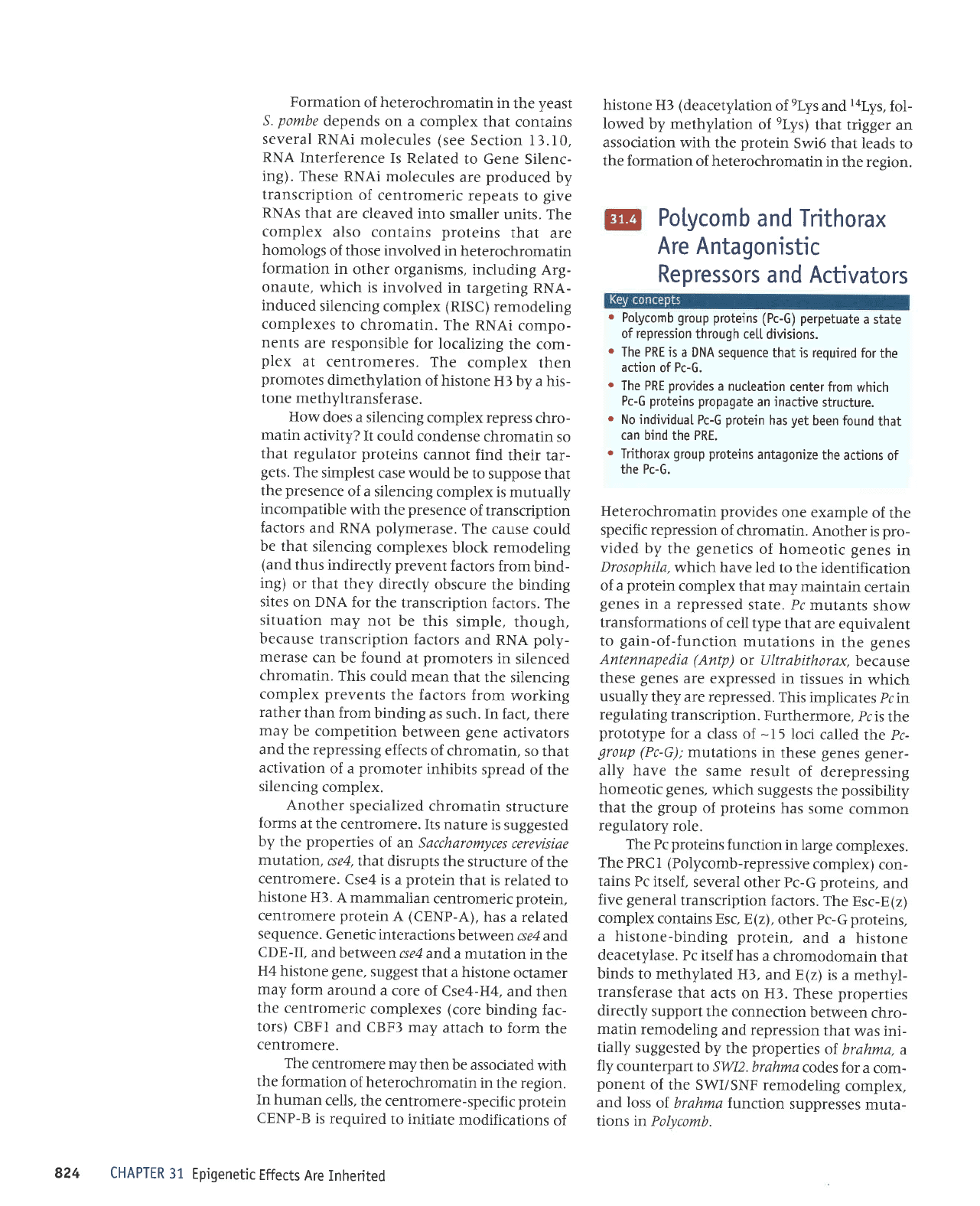
Formation
of heterochromatin
in
the
yeast
S.
pombe
depends
on a complex
that
contains
several
RNAi
molecules
(see
Section ll.I0,
RNA
Interference
Is Related
to Gene
Silenc-
ing).
These
RNAi molecules
are
produced
by
transcription
of
centromeric
repeats
to
give
RNAs
that are
cleaved into
smaller
units. The
complex
also contains proteins
that
are
homologs
of those involved
in
heterochromatin
formation
in
other organisms,
including
Arg-
onaute, which
is involved
in
targeting RNA-
induced
silencing
complex
(RISC)
remodeling
complexes
to chromatin.
The
RNAi
compo-
nents
are
responsible
for localizing
the com-
plex
at centromeres.
The
complex
then
promotes
dimethylation
of histone
H3 by
a his-
tone
methyltransferase.
How
does a
silencing
complex repress
chro-
matin
activity?
It could
condense
chromatin
so
that
regulator proteins
cannot
find
their tar-
gets.
The
simplest
case would
be
to suppose
that
the
presence
of a silencing
complex
is mutually
incompatible
with
the
presence
of transcription
factors
and RNA
polymerase.
The
cause
could
be that
silencing
complexes
block remodeling
(and
thus
indirectly
prevent
factors
from
bind-
ing)
or that
they directly
obscure
the
binding
sites
on DNA
for the
transcription
factors.
The
situation
may not
be this
simple,
though,
because
transcription
factors
and
RNA
pory-
merase
can
be found
at
promoters
in
silenced
chromatin.
This could
mean
that
the silencing
complex prevents
the factors
from
working
rather
than
from
binding
as such. In
fact,
there
may
be
competition
between
gene
activators
and the
repressing
effects
of chromatin,
so
that
activation
of a
promoter
inhibits
spread
of the
silencing
complex.
Another
specialized
chromatin
structure
forms
at the
centromere.
Its
nature is
suggested
by the properties
oI an Saccharlmyces
cerevisiae
mutation,
cse4,
that disrupts
the
structure
of the
centromere.
Cse4 is
a
protein
that
is related
to
histone
H3.
A mammalian
centromeric protein,
centromere protein
A
(CENP-A),
has a related
sequence.
Genetic interactions
between
cse4
and
CDE-II,
and
between
cse4
anda
mutation
in the
H4
histone gene,
suggest
that
a histone
octamer
may
form
around
a
core of
Cse4-H4,
and
then
the
centromeric
complexes (core
binding
fac-
tors)
CBFI
and CBF3
may
attach
to form
the
centromere.
The
centromere
may then
be
associated
with
the formation
of
heterochromatin
in
the region.
In
human
cells,
the centromere-specific
protein
CENP-B
is
required
to initiate
modifications
of
Effects
Are
Inherited
histone
H3
(deacetylation
of
elys
and
lalys,
fol-
lowed
by methylation
of
elys)
thar trigger
an
association
with the
protein
Swi6 that
leads to
the formation
of heterochromatin
in
the resion.
Polycomb
and Trithorax
Are Antagonistic
Repressors
and
Activators
o
Polycomb
group proteins
(Pc-G) perpetuate
a state
of repression
through ce[[
divisions.
r
The PRE is
a DNA sequence
that is required
for
the
action
of Pc-G.
r
The PRE
provides
a nucteation
center from
which
Pc-G
proteins
propagate
an inactive
structure.
.
No individual
Pc-G
protein
has
yet
been found
that
can bind the PRE.
o
Trithorax
group proteins
antagonize
the
actions
of
the Pc-G.
Heterochromatin
provides
one
example
of
the
specific repression
of chromatin.
Another
is
pro-
vided by
the
genetics
of homeotic genes
in
Drosophila,
which have led
to the
identification
of a
protein
complex
that may
maintain
certain
genes
in
a repressed
stale. Pc
mutants
show
transformations
of cell type
that
are equivalent
to
gain-of-function
mutations
in
the
genes
Antennap
e dia
(Antp
)
or U ltrab
ithorax,
becatse
these
genes
are
expressed
in tissues
in
which
usually
they are repressed.
This
implicates
pc
in
regulating
transcription.
Furthermore,
Pc is
the
prototype
for
a class
of
-I5
loci
called
the
pc-
group
(Pc-G);
mutations
in
these
genes
gener-
ally have
the
same result
of
derepressing
homeotic genes,
which
suggests
the
possibility
that
the
group
of
proteins
has
some
common
regulatory
role.
The
Pc
proteins
function
in
large
complexes.
The
PRCI
(Polycomb-repressive
complex)
con-
tains
Pc itself,
several
other Pc-G proteins,
and
five
general
transcription
factors.
The
Esc-E(z)
complex
contains
Esc,
E(z),
other Pc-G proteins,
a histone-binding
protein,
and
a
histone
deacetylase.
Pc itself
has
a chromodomain
that
binds
to methylated
H3,
and E(z)
is
a merhyl-
transferase
that acts
on H3.
These properties
directly
support
the connection
between
chro-
matin
remodeling
and repression
that
was ini-
tially
suggested
by the
properties
of
brahma,
a
fly
counterpartlo
SW2.
brahma
codes
for a
com-
ponent
of
the SWI/SNF
remodeling
complex,
and
loss
of brahma
function
suppresses
muta-
tions
in Polycomb.
824
CHAPTER
31 Epigenetic
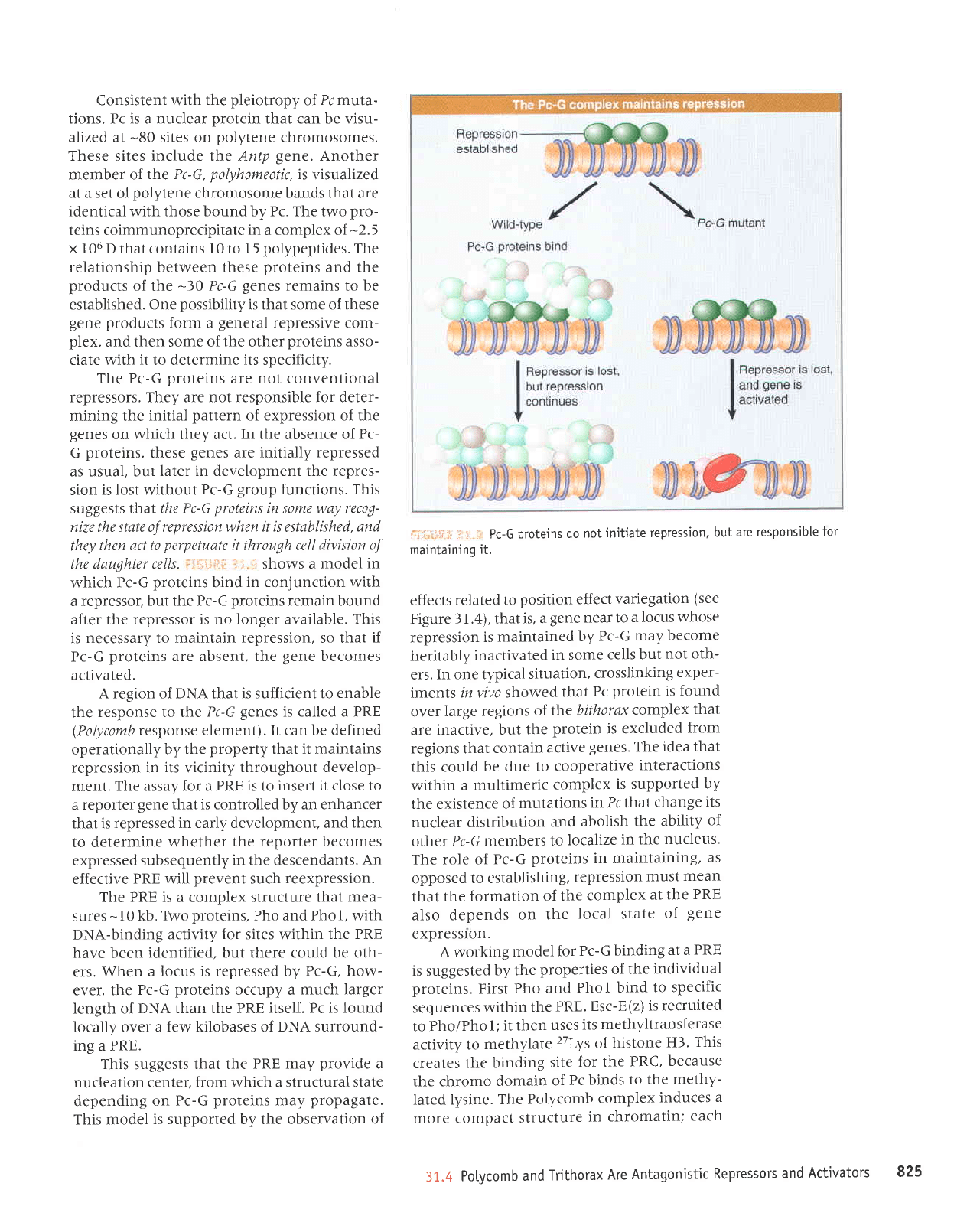
Consistent with
the
pleiotropy
of
Pc muta-
tions, Pc is a nuclear
protein
that can be visu-
alized at
-80
sites on
polytene
chromosomes.
These sites include rhre Antp
gene.
Another
member of
the Pc-G,
polyhomeotic,
is
visualized
at a set of
polytene
chromosome bands that are
identical with those bound by Pc. The two
pro-
teins coimmunoprecipitate
in
a complex of
-2.5
x
106 D thatcontains l0 to 15
polypeptides.
The
relationship between these
proteins
and the
products
of the 40
Pc-G
genes
remains to be
established.
One
possibility
is that some of these
gene products
form a
general
repressive com-
plex,
and then some of the other
proteins
asso-
ciate with
it
to determine
its
specificity.
The Pc-G
proteins
are not conventional
repressors. They are not responsible for deter-
mining the
initial
pattern
of expression of the
genes
on which they act.
In
the absence
of Pc-
G
proteins,
these
genes
are initially
repressed
as usual, but
later in development the repres-
sion
is lost without
Pc-G
group
functions.
This
suggests that
the Pc-G
proteins
in some way rec1g-
nize the state of repressionwhen
itis
established,
and
they
then act t0
perpetuate
it thrlugh cell
division of
the daughter
cells.
;:::t,:':,:t- ,,
I
r
shows a model
in
which Pc-G
proteins
bind
in conjunction with
a repressor,
but the Pc-G
proteins
remain bound
after
the repressor
is no longer
available.
This
is
necessary to maintain repression, so that
if
Pc-G
proteins
are absent, the
gene
becomes
activated.
A
region of DNA that is sufficient to
enable
the
response to the
Pc-G
genes
is called a PRE
(Polycomb
response element). It can be defined
operationally
by
the
property
that it maintains
repression in
its
vicinity
throughout develop-
ment.
The assay for a PRE
is
to
insert it close to
a
reporter
gene
that is controlled by an enhancer
that is
repressed in early development, and
then
to determine
whether
the reporter becomes
expressed
subsequently
in
the descendants.
An
effective
PRE will
prevent
such
reexpression.
The
PRE is a complex structure that
mea-
sures
-
I 0 kb. TWo
proteins,
Pho and Pho I
,
with
DNA-binding
activity for sites within
the PRE
have been
identified, but there could be oth-
ers. When
a locus is
repressed
by
Pc-G, how-
ever, the
Pc-G
proteins
occupy a
much larger
Iength of
DNA than the PRE itself.
Pc is found
locally
over a few
kilobases of DNA surround-
ing a PRE.
This suggests
that the
PRE may
provide
a
nucleation center,
from which a structural
state
depending
on
Pc-G
proteins
may
propagate.
This model
is supported by the observation
of
tirrri,t',,
I:,r
Pc-Gproteinsdonotinitiaterepression.butareresponsib[efor
maintaining
it.
effects
related to
position effect
variegation
(see
Figure 3I.4), that
is, a
gene near to
a locus
whose
repression
is maintained
by
Pc-G
may become
heritably
inactivated
in some
cells but
not
oth-
ers.
In one typical
situation,
crosslinking
exper-
iments
in vivo showed
that
Pc
protein is found
over
large
regions
of the
bithorax
complex
that
are
inactive, but
the
protein is excluded
from
regions that
contain
active
genes. The idea
that
this could be
due
to cooperative
interactions
within
a multimeric
complex
is supported
by
the existence
of
mutations
in Pc that
change
its
nuclear
distribution
and
abolish
the
ability
of
other Pc-G
members
to
localize
in the
nucleus.
The role of
Pc-G
proteins
in maintaining,
as
opposed
to establishing,
repression
must
mean
that
the formation
of the
complex
at the
PRE
also depends
on
the
local state
of
gene
expressron.
A
working
model
for
Pc-G
binding
at a
PRE
is suggested
by the
properties of the
individual
proteins. First
Pho and
PhoI
bind
to specific
sequences
within
the PRE.
Esc-E(z)
is recruited
to Pho/Phol;
it then
uses
its methyltransferase
activity to
methylate
27Lys
of histone
Hl.
This
creates
the binding
site
for the
PRC,
because
the chromo
domain
of
Pc
binds
to the
methy-
Iated lysine.
The
Polycomb
complex
induces
a
more compact
structure
in
chromatin;
each
31.4
Potycomb
and
Trithorax
Are
Antagonistic
Repressors
and
Activators
825
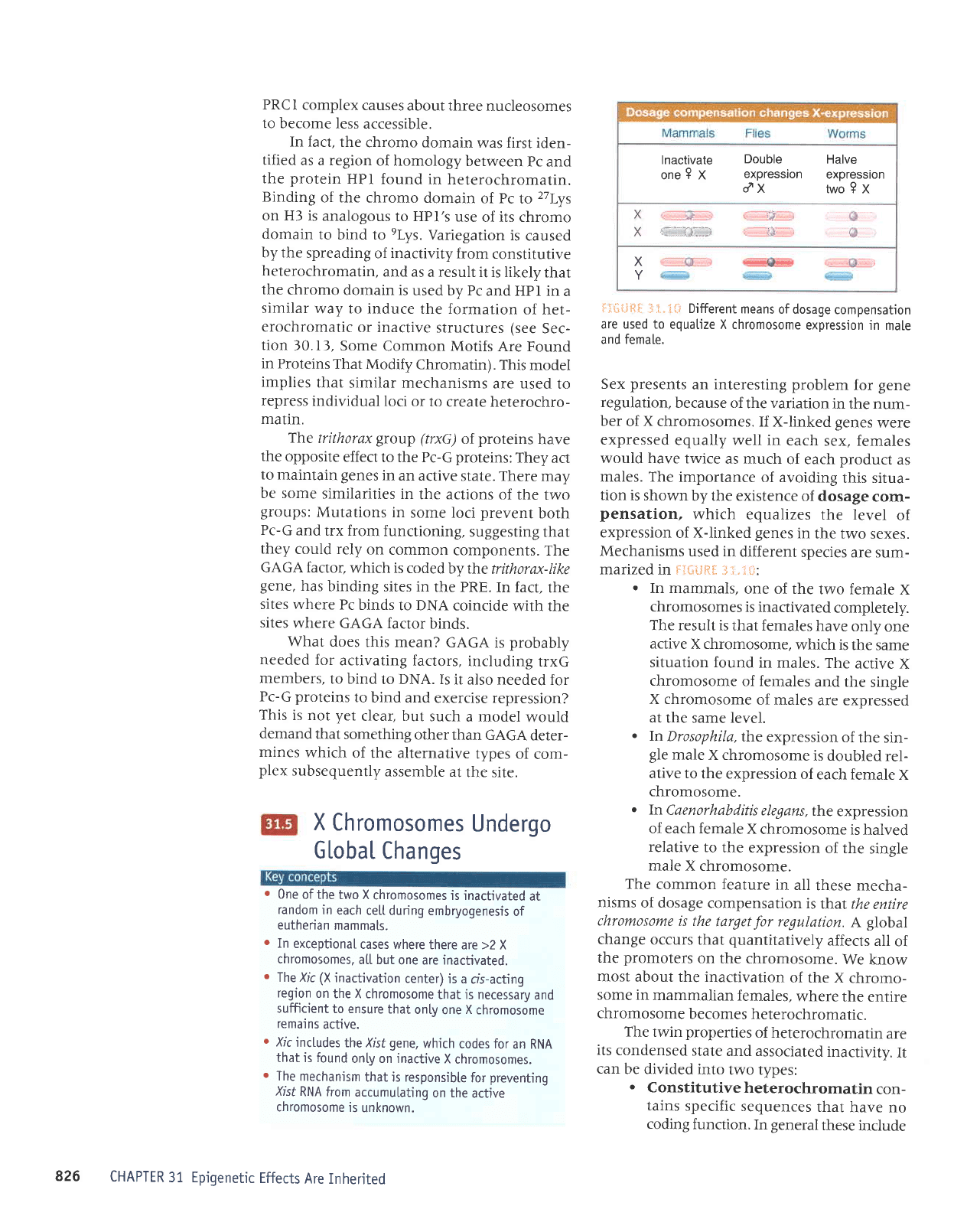
PRC
I complex
causes
about three
nucleosomes
to become
less accessible.
In fact,
the
chromo domain
was first
iden-
tified
as a region
of homology
between
Pc and
the
protein
HPI found
in heterochromatin.
Binding
of the
chromo domain
of Pc
to
27lys
on H3
is analogous
to HPI's
use
of its chromo
domain
to
bind to
elys.
Variegation
is
caused
by the
spreading
of
inactivity
from constitutive
heterochromatin,
and as
a result it is Iikely
that
the
chromo
domain is
used by Pc
and HPI in
a
similar
way to induce
the formation
of het-
erochromatic
or inactive
structures
(see
Sec-
tion
10.13,
Some
Common Motifs
Are Found
in
Proteins
That Modify
Chromatin).
This
model
implies
that
similar mechanisms
are used
to
repress
individual
loci
or to
create heterochro-
matin.
The
trithorax group (trxG)
of
proteins
have
the
opposite
effect
to the Pc-G
proteins:
They act
to
maintain genes
in
an active
state.
There may
be some
similarities
in
the actions
of the
two
groups:
Mutations
in
some loci prevent
both
Pc-G
and
trx from
functioning,
suggesting
that
they
could rely
on
common
components.
The
GAGA factor,
which
is coded
by rhe
trithorax-like
gene,
has
binding
sites in
the PRE.
In fact,
the
sites where
Pc
binds
to DNA
coincide
with the
sites
where
GAGA factor
binds.
What
does
this mean?
GAGA
is
probably
needed
for
activating
factors,
including
trxG
members,
to bind
to DNA. Is
it also
needed for
Pc-G
proteins
to
bind and
exercise
repression?
This
is not
yet
clear, but
such
a model
would
demand
that
something
other
than GAGA
deter-
mines
which
of
the alternative
types of
com-
plex
subsequently
assemble
at
the site.
X
Chromosomes
Undergo
Gl.obaI
Changes
o
One
of the
two X
chromosomes
is inactivated
at
random
in
each celt during
embryogenesis
of
eutherian
mammats.
o
In
exceptional
cases where
there
are
>2
X
chromosomes,
at[ but
one are inactivated.
o
The Xrc (X
inactivation
center)
is
a crs-acting
region
on
the X chromosome
that is necessary
and
sufficient
to ensure
that
onLy
one
X
chromosome
remains
active.
r
Xrc
inctudes
the Xrsf
gene.
which
codes for
an RNA
that is found
onty on inactive
X
chromosomes.
o
The
mechanjsm
that is responsible
for
preventing
Xtsf
RNA from
accumutating
on the
active
chromosome
is
unknown.
+.1*iJ**
.it t.1{i Different
means
of dosage
compensation
are used to
equatize X chromosome
expression in
mare
and female.
Sex
presents
an
interesting problem
for
gene
regulation,
because of
the
variation
in the num-
ber
of
X
chromosomes.
If X-linked genes
were
expressed
equally well in
each
sex, females
would have
twice
as much
of each
product
as
males. The
importance
of avoiding
this situa-
tion
is shown
by the existence
of
dosage
com-
pensation,
which
equalizes
the level
of
expression
of X-linked
genes
in
the two
sexes.
Mechanisms
used in
different
species
are sum-
marized
in
!:lil*qil
"!.i.:*:
.
In mammals,
one of the
two female
X
chromosomes
is
inactivated
completely.
The result
is that females
have
only
one
active
X chromosome,
which is
the same
situation found
in males.
The
active
X
chromosome
of females
and the
single
X chromosome
of males
are expressed
at
the same level.
.
In
Drosophila,
tll'e
expression
of
the sin-
gle
male
X chromosome
is doubled
rel-
ative to
the expression
of
each female
X
chromosome.
.
In
Caenorhabditis
elegans,
the
expression
of each female
X
chromosome
is
halved
relative
to
the expression
of the
single
male
X chromosome.
The
common feature
in
all
these
mecha-
nisms
of dosage
compensation
is
that the
entire
chromosome
is the
target
for
regulation.
A
global
change
occurs
that
quantitatively
affects
all
of
the
promoters
on the
chromosome.
We know
most
about the inactivation
of the X
chromo-
some in
mammalian
females,
where
the
entire
chromosome
becomes
heterochromatic.
The
twin
properties
of heterochromatin
are
its
condensed
state
and associated
inactivity.
It
can
be divided
into
two types:
.
Constitutiveheterochromatin
con-
tains
specific
sequences
that
have no
coding
function.
In
general
these
include
Inactivate
Double
Halve
one9X
expression
expression
ix
two I X
X
r-j
r:
x
i._.,-_.ij...)
|
Xo
826
CHAPTER
31 Epigenetic
Effects
Are
Inherited
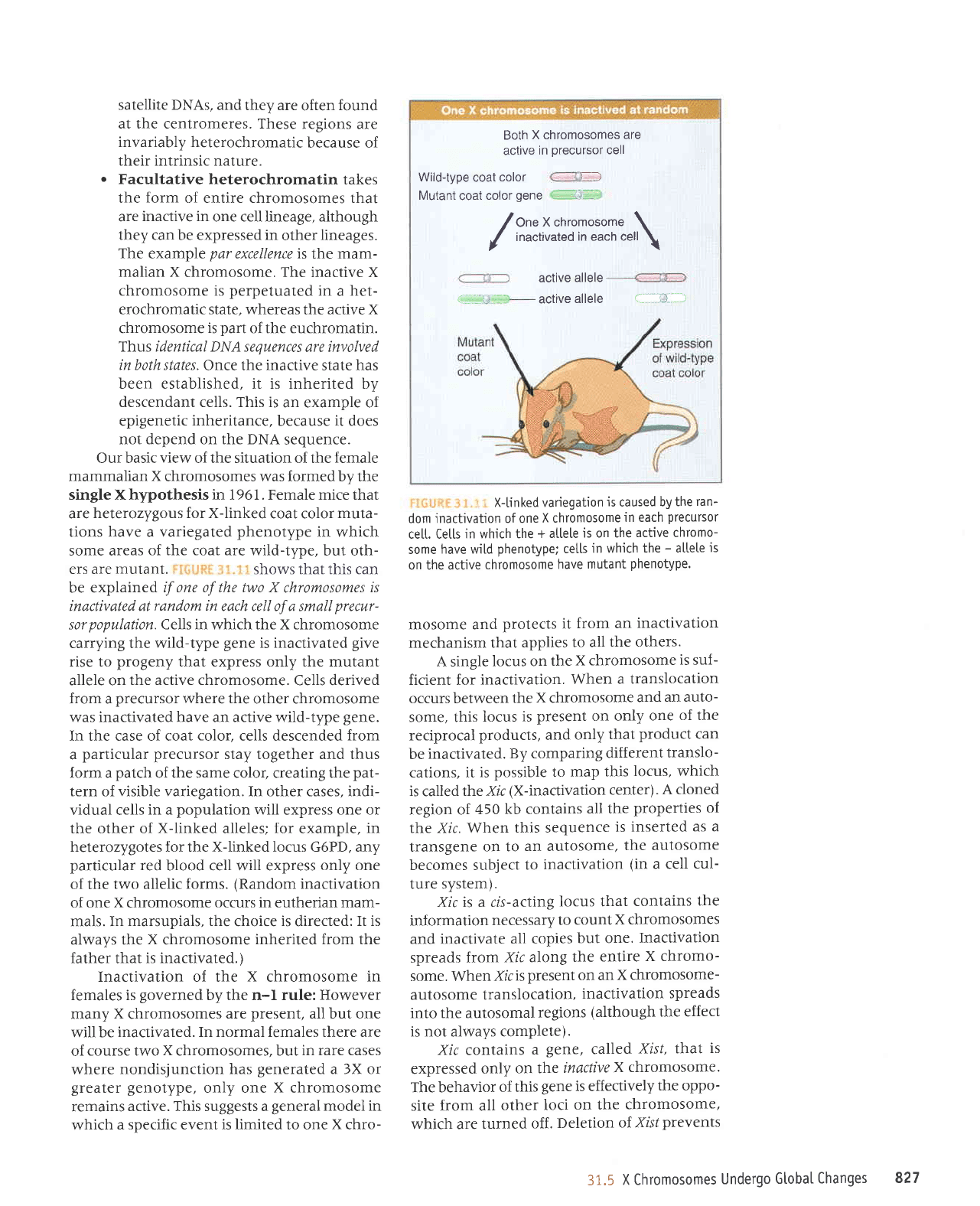
satellite DNAs,
and they are
often
found
at the centromeres. These
regions are
invariably heterochromatic
because of
their intrinsic nature.
.
Facultative heterochromatin
takes
the
form
of entire chromosomes that
are
inactive in
one cell lineage, although
they can be expressed in
other
lineages.
The example
par
excellence is
the
mam-
malian X
chromosome. The inactive X
chromosome is
perpetuated
in a het-
erochromatic state, whereas
the
active X
chromosome
is
part
of the euchromatin.
Thtrs identical DNA sequences
are involved
in both states.
Once the inactive state has
been established, it is inherited by
descendant cells. This is
an example of
epigenetic
inheritance,
because it does
not depend on the DNA
sequence.
Our basic
view
of the situation of the
female
mammalian
X
chromosomes was formedby the
single X hypothesis in 1961 . Female mice that
are
heterozygous for X-linked
coat color
muta-
tions have a variegated
phenotype
in which
some areas
of the coat are
wild-type, but oth-
ers are mutant. shows that this can
be explaine
d if one of the two X
chromosomes
ts
inactivated at
random in
each cell of a small
precur-
sor
population
Cells in which the X chromosome
carrying the wild-type
gene
is inactivated
give
rise to
progeny
that express only the mutant
allele on
the active chromosome.
Cells derived
from a
precursor
where the
other chromosome
was inactivated have an active wild-type
gene.
In the case of coat
color,
cells descended
from
a
particular
precursor
stay together and thus
form a
patch
of the same color, creating the
pat-
tern of visible variegation. In other cases, indi-
vidual cells
in a
population
will
express
one or
the other of
X-linked
alleles;
for
example,
in
heterozygotes for the X-linked locus G6PD, any
particular
red
blood cell will express
only one
of the
two allelic forms.
(Random
inactivation
of one
X
chromosome
occurs in eutherian marrr-
mals. In
marsupials, the
choice
is
directed:
It is
always the
X
chromosome
inherited from the
father
that
is inactivated.)
Inactivation of the
X
chromosome
in
females is
governed
by the n-l rule: However
many
X
chromosomes
are
present,
all but one
will be
inactivated. In normal females there are
of
course two
X
chromosomes, but
in rare cases
where
nondisjunction has
generated
a 3X or
greater
genotype,
only one
X
chromosome
remains
active. This suggests a
general
model in
which
a specific event is limited to one
X
chro-
,
'
X-tinked variegation
is
caused
by the
ran-
dom
inactivation of one
X chromosome
in each
precursor
ce[t. Cetts
in which the
+ attete
is on the
active chromo-
some
have wil"d
phenotype;
cetls
in which
the
-
altete
js
on the active
chromosome
have
mutant
phenotype.
mosome and
protects
it
from an
inactivation
mechanism that
applies
to all
the others.
A single
locus on
the
X chromosome
is
suf-
ficient for
inactivation.
When
a translocation
occurs between
the
X
chromosome
and
an auto-
some, this
iocus
is
present on only
one
of the
reciprocal
products,
and
only
that
product
can
be
inactivated.
By comparing
different
translo-
cations, it
is
possible to map
this
locus, which
is
called
the Xic
(X-inactivation
center).
A cloned
region of
450 kb contains
all the
properties of
tlne Xic. When
this sequence
is
inserted
as a
transgene
on to
an autosome,
the autosome
becomes subject
to
inactivation
(in
a cell
cul-
ture system).
Xic is a cis-acting
locus that
contains
the
information
necessary
to
count
X chromosomes
and inactivate
all copies
but one.
Inactivation
spreads
from
Xic along
the
entire
X chromo-
some. When
Xlc
is
present on an
X chromosome-
autosome
translocation,
inactivation
spreads
into the autosomal
regions
(although the effect
is not
always
complete).
Xic conrains
a
gene,
called
Xist, that
is
expressed
only
on the
inactive
X
chromosome.
The behavior
of this
gene
is effectively
the oppo-
site from all
other
loci
on the
chromosome,
which are
turned
off .
Deletion
of Xlsl
prevents
Both
X chromosomes
are
active
in
precursor
cell
Wild-type
coat
color
.
Mutant
coat
color
gene
/
n:2,:,:z:"n:'""Jl:"\
active
allele
.,--..,:l
active
allele
.-
-i?--J
31.5
X Chromosomes
Undergo
GlobaI
Changes
827

X-inactivation
invo[ves
stabitization
of
Xrst
RNA, which
coats the inactive
chromosome.
an X
chromosome
from being
inactivated.
It
does
not, however,
interfere
with
the counting
mechanism
(because
other X chromosomes
can
be inactivated).
Thus
we can
distinguish
two
features
of. Xic:
an unidentified
element(s)
required
for counting,
and
the Xist
gene
required
for inactivation.
i
ir,
,
,
::
i:
,
.
.
. illustrates
the role
of
Xlsf
RNA
in X-inactivalion.
Xist
codes for
an RNA that
Iacks
open reading
frames.
The XzslRNA
"coaIs"
the
X chromosome
from
which it is
synthesized,
which
suggests that it
has a
structural role.
Prior
to X-inactivation,
it is
synthesized
by both female
X
chromosomes.
Following
inactivation,
the
RNA
is found
only
on the inactive
X
chromo-
some. The
transcription
rate remains
the
same
before
and after inactivation,
so the
transition
depends
on
posttranscriptional
events.
Prior
to X-inactivation,
Xist
RNA
decays
with
a
half
life
of
-2
hours.
X-inacrivation
is
mediated
by
stabilizing
the XrilRNA
on the inac-
tive X
chromosome.
The XlslRNA
shows a
punc-
tate
distribution
along
the X
chromosome,
which
suggests
that
association
with
proteins
to form
particulate
structures
may
be the means
of
stabilization.
We
do not know
yet
what other
factors
may
be involved
in
this reaction
and
how
the Xlsl RNA
is limited
to spreading in
cli
along
the
chromosome.
The
characteristic
fea-
tures
of the inactive
X
chromosome,
which
include
a lack
of acetylation
of histone H4,
and
methylation
of
CpG sequences (see
Section
Epigenetic
Effects
Are
Inherited
24.19,
CpG
Islands
Are Regulatory
Targets).
pre-
sumably occur later as
part
of the mechanism
of inactivation.
The n-l
rule suggests
that stabilization
of
Xrsl RNA
is the
"default,"
and that some
block-
ing
mechanism
prevents
stabilization
at one X
chromosome
(which
will be the
active X). This
means
that, although Xic is
necessary
and suf-
ficient for
a chromosome to
be inactivated,
the
products
of other loci may
be necessary
for
the
establishment
of an active X chromosome.
Silencing
of Xlsl expression
is necessary
for
the active X. Deletion
of the
gene
for DNA
methyltransferase
prevents
silencing
of. Xist,
probably
because methylation
at
Ihe Xist
pro-
moter is necessary for
cessation
of transcription.
Chromosome
Condensation
Is
Caused
by Condensins
.
SMC
proteins
are
ATPases
that inctude
the
condensins
and the cohesins.
r
A heterodimer
of SMC
proteins
associates
with
other subunits.
r
The
condensins
cause chromatin
to be more
tightty
coited by
introducing
positive
supercoits
into DNA.
o
Condensins are responsibte
for condensing
chromosomes at mitosis.
.
Chromosome-specific
condensins
are respons'ibte
for
condensing inactive X
chromosomes
in
C.
elegons.
The
structures of entire
chromosomes
are influ-
enced by interactions
with
proteins
of the SMC
(structural
maintenance
of
chromosome)
family.
They are ATPases
that fall
into
two func-
tional
groups.
Condensins
are involved
with
the control of
overall structure,
and
are respon-
sible for the
condensation
into compact
chro-
mosomes
at mitosis.
Cohesins
are
concerned
with connections
between
sister
chromatids
that must
be released
at mitosis.
Both
consist
of
dimers formed
by SMC
proteins.
Condensins
form
complexes
that have
a core
of the het-
erodimer
SMC2-SMC4
associated
with
other
(non-SMC)
proteins.
Cohesins have
a similar
organization
based
on the heterodimeric
core of
SMCI-SMC3.
i li,i.;l;
I
:.
i ,: shows
that an
SMC
protein
has
a coiled-coil
structure in
its center
that
is inter-
rupted
by a flexible
hinge region.
Borh
the
amino and
carboxyl
termini have
ATP-
and
DNA-binding
motifs.
Different
models
have
been
proposed
for
the actions
of these
proteins
CHAPTER
31
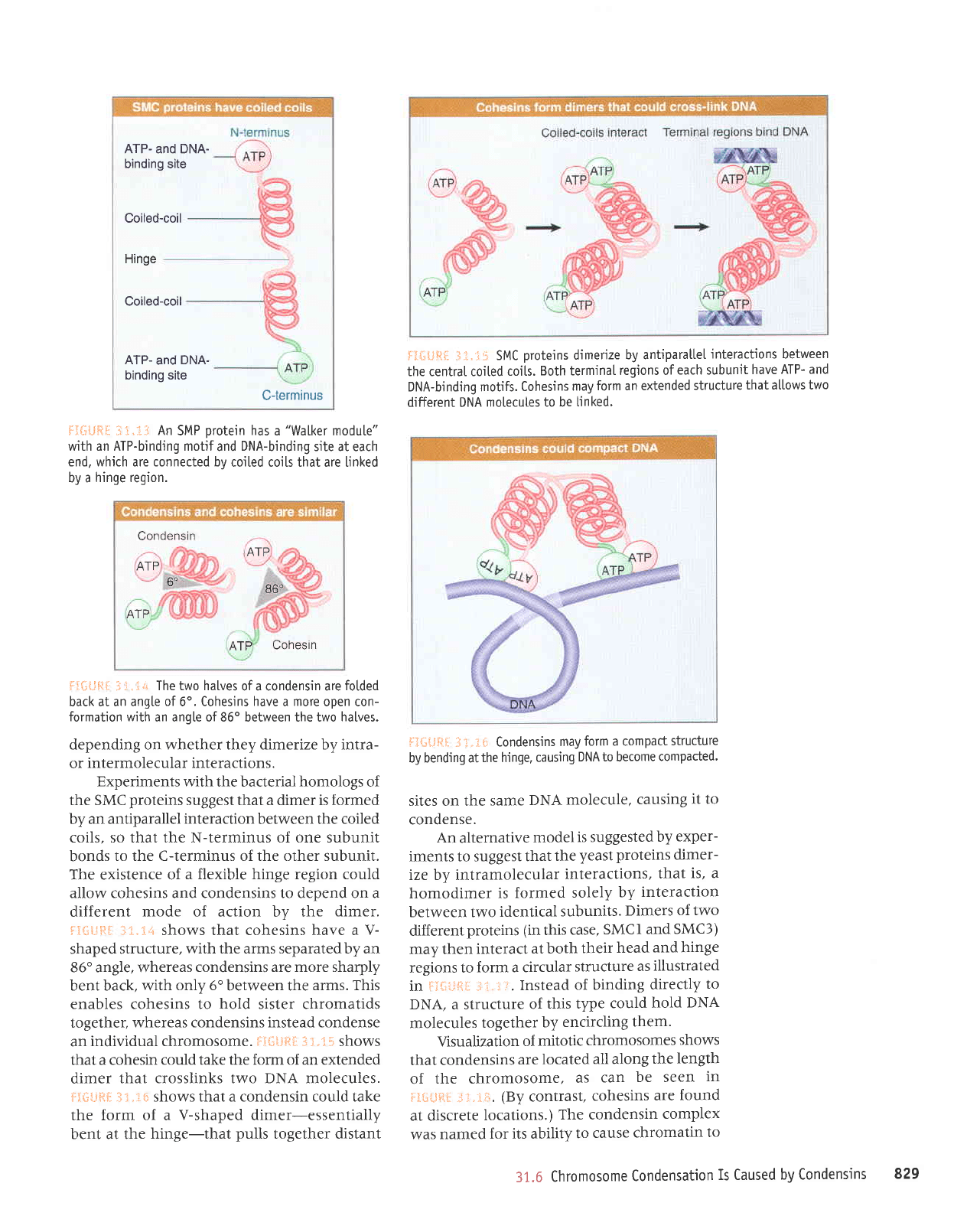
ATP- and DNA-
binding site
Coiled-coil
Hinge
Coiled-coil
ATP-
and
DNA-
binding site
C-terminus
il5iitlftE: ;i
-i.i:i An
SMP
protein
has
a
"Walker
modute"
with an ATP-binding motif
and
DNA-binding
site at each
end, which are connected bv
coiled coi[s that are [inked
by a
hinge region.
F..I$*i{{ i:.::i
SMC
proteins
dimerjze
by antiparatteI
interactions between
the centraI coited
coits.
Both terminaI
regions of
each subunit
have
ATP- and
DNA-binding motifs.
Cohesins
may
form an extended
structure
that atlows two
different DNA
motecutes to be
[inked.
Condensin
ATP
ATP
-
86"
ATP
ATP
Cohesin
Flt]t"!l-l{ -:;1.:r-J
The two halves
of a condensin are
fotded
back at an angte
of
6o. Cohesins
have
a
more
open con-
formation with
an angle of 86o between the two
halves.
depending on whether they dimerize by intra-
or
intermolecular interactions.
Experiments
with the bacterial
homologs
of
the SMC
proteins
suggest that a dimer is formed
by an antiparallel
interaction
between the coiled
coils, so that the N-terminus of one subunit
bonds
to the C-terminus of the other subunit.
The existence of
a flexible hinge region could
allow cohesins and condensins to depend on a
different
mode
of action by the
dimer.
f:*it-i*i i.1.1.! shows that cohesins have a V-
shaped structure,
with the arms separated by an
86'angle, whereas
condensins are more sharply
bent back, with
only 6o
between the
arms. This
enables cohesins to hold sister chromatids
together,
whereas condensins instead condense
an individual chromosome. *:.i*li*L: :'*1":.* shows
that a cohesin
could take the form of an extended
dimer
that crosslinks two DNA molecules.
Ft*L{**
3:: . .r
+
shows that a condensin could take
the form of a
V-shaped
dimer-essentially
bent at the
hinge-that
pulls
together distant
ilItiLigfi
.1 1""'itl
Condensins
may
form a compact
structure
by bending at
the hinge, causing
DNA to become
compacted'
sites on the
same
DNA
molecule,
causing
it to
condense.
An
alternative
model
is suggested
by
exper-
iments to suggest
that
the
yeast
proteins dimer-
ize by intramolecular
interactions,
that
is, a
homodimer
is formed
solely
by
interaction
between two
identical
subunits.
Dimers
of two
different
proteins
(in
this
case,
SMC
I and SMCS)
may then
interact
at both
their
head
and hinge
regions to
form a circular
structure
as
illustrated
in ru*i.:El-: iri.,l
,r.
Instead
of binding
directly
to
DNA, a structure
of
this type
could
hold
DNA
molecules
together
by
encircling
them.
Visualization
of mitotic
chromosomes
shows
that condensins
are
located
all along
the
length
of
the chromosome,
as
can
be seen
in
If.{;Ltit{:1 i.t*i.
(By
contrast,
cohesins
are
found
at discrete
locations.)
The condensin
complex
was
named
for its ability
to
cause
chromatin
to
31.6
Chromosome
Condensation
Is Caused
by Condensins
829
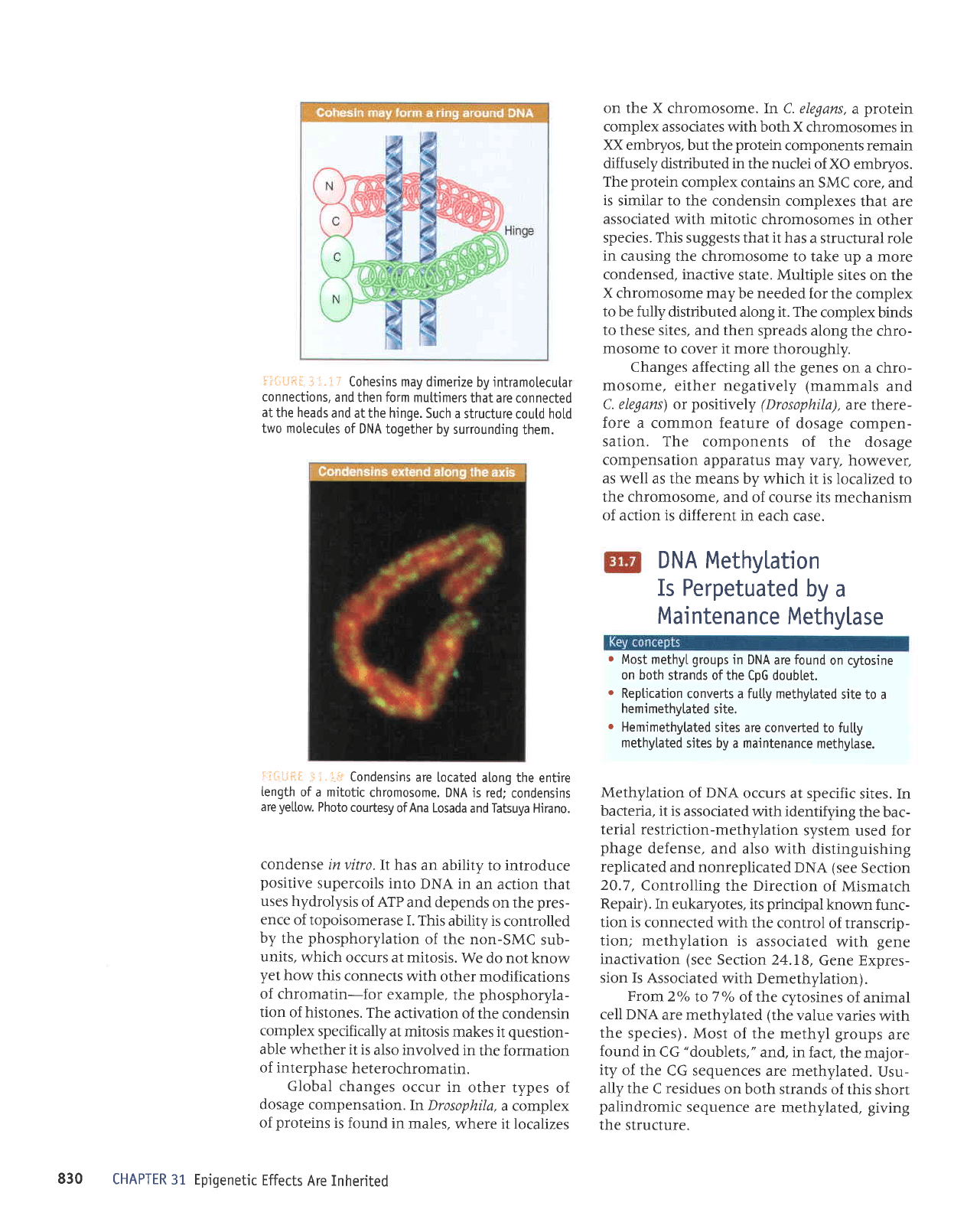
i'ii:.iRi
--:.i.:...r
Cohesins may dimerize
by intramotecutar
connections,
and
then
form
muttimers
that are
connected
at
the
heads
and at the hinge.
Such a structure
coutd ho[d
two motecutes
of DNA together
by surrounding
them.
I.iiL:liI
i:i.]S
Condensins
are located
atonq the
entire
Length
of a mitotic
chromosome. DNA
is red;
condensins
are
yetlow.
Photo
courtesy
ofAna Losada
and Tatsuya Hirano.
condense
in vitro.It
has
an ability
to introduce
positive
supercoils
into
DNA in
an action
that
uses
hydrolysis
of AIP
and depends
on the
pres-
ence
of topoisomerase
I. This
ability is
controlled
by
the
phosphorylation
of the non-SMC
sub-
units.
which
occurs at mitosis.
We do not know
yet
how
this connects
with
other modifications
of chromatin-for
example,
the
phosphoryla-
rion
of histones.
The
acrivation
of the
condensin
ilkff
ffi *1iL1t*"J",#iisH*T;
Global
changes
occur in
other types
of
dosage
compensation.In
Drosophila,
a complex
of
proteins
is
found in
males,
where it localizes
CHAPTER
31 Epigenetic
Effects
Are Inherited
on
the
X
chromosome. In C. elegans,
a
protein
complex associates with both X
chromosomes in
XX
embryos, but the
protein
components remain
diffusely distributed in
the
nuclei
of XO
embryos.
The
protein
complex contains an
SMC core, and
is similar to the
condensin complexes
that are
associated
with mitotic chromosomes
in other
species. This suggests that it has
a structural role
in
causing the chromosome
to take
up a more
condensed, inactive
state. Multiple
sites on the
X
chromosome may
be
needed
for the
complex
to be fully
distributed along it. The
complex
binds
to these sites, and then
spreads along
the chro-
mosome
to cover it more
thoroughly.
Changes
affecting all the
genes
on a chro-
mosome/
either negatively
(mammals
and
C. elegans) or
positively
(Drosophila),
are there-
fore
a common feature
of dosage
compen-
sation. The
components
of the dosage
compensation
apparatus may vary,
however,
as well
as the means by
which it is localized
to
the chromosome,
and of course its
mechanism
of action is
different in each
case.
DNA Methylation
Is Perpetuated
by
a
Maintenance
Methylase
o
Most methyl
groups
in DNA
are
found
on cytosine
on both
strands of the CpG
doublet.
r
RepUcation
converts a fuLty methytated
site to a
hemimethylated
site.
r
Hemimethytated
sites are
converted
to
futty
methytated
s'ites
by a maintenance
methylase.
Methylation
of DNA occurs
at specific
sites. In
bacteria, it is
associated
with identifying
the
bac-
terial
restriction-methylation
system
used for
phage
defense, and
also with
distinguishing
replicated
and nonreplicated
DNA
(see
Section
20.7,
Controlling
the Direction
of Mismatch
Repair). In
eukaryotes, its
principal
knor,rm
func-
tion is
connected with
the control
of transcrip-
tion;
methylation is
associated
with
gene
inactivation
(see
Section
24.18,
Gene Expres-
sion Is Associated with
Demethylation).
From
2o/o
to
7
o/o
of the
cytosines
of animal
cell DNA
are methylated
(the
value
varies
with
the
species). Most
of the
methyl
groups
are
found in
CG
"doublets,"
and, in
fact,
the major-
ity
of the
CG sequences
are methylated.
Usu-
ally the
C
residues
on both strands
of this
short
palindromic
sequence
are methylated, giving
the
structure.
830
